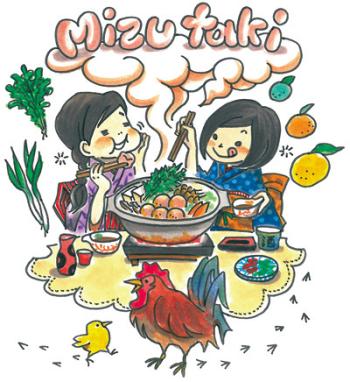Hakata Culture vol.46
History of Hakata’s Mizutaki

When the weather grows cold and the north wind blows, I get an appetite for nabe ryori. When young people think of nabe ryori in Fukuoka/Hakata, motsunabe comes to mind, but those with longer memories will think of mizutaki.
“The defining trait of Hakata culture is to take something that comes from somewhere else and skillfully rearrange it so that it becomes something that seems to have always been a local specialty. That’s also true of food,” observed the late Einosuke Obiya, a historian who specialized in manners and customs and the first director of the Hakata-machi Culture League. Mizutaki is a case in point.
The dish, which some people consider to be typical Japanese cuisine, is actually said to have been created by combining Chinese and Western elements. The man who by all accounts got the idea for the dish was Heisaburo Hayashida, the proprietor of a famous shop now located at 3 Hirao, Chuo Ward. A Nagasaki native, Hayashida traveled to Hong Kong at the age of 15 and lived with an English family. He studied Western cooking during his stay. After returning to Japan, he blended consommé with the Chinese method of simmering chicken in water to create a plain soup. To this he added seasonal vegetables, udon, and mochi to create a type of zosui in the Japanese style. He brought the dish to Fukuoka in 1905 when he opened his shop, Suigetsu. From there it spread throughout the country, where it became known as Hakata-ni.
To properly enjoy mizutaki, first put the chicken broth in a bowl, add Hakata green onions and kotonegi for flavor, and savor the taste. Then eat the chicken. Next, put Chinese cabbage or cabbage into the pot and add tofu, spring chrysanthemum, and mushrooms. Squeeze in the juice of a citrus fruit, like citron, sudachi, or bitter orange, and then flavor with soy sauce and yuzugosho. It’s not just for winter meals―Hakata-dwellers eat it year-round.
Obiya once explained that during the 500-year period before Sakai in Osaka became a port during the Kamakura period, foreign culture came to Japan almost exclusively through Hakata. It’s no surprise, then, that new food and eating styles came to Hakata first and then spread to the rest of the country.The legacy of this foreign influence can still be felt in Fukuoka to this day, in delicious creations such as mizutaki. Long may it continue!
博多の名物鍋「水炊き」は中国料理と西洋料理がヒントになって誕生
北風が吹き始めて、寒くなってくると(今年寒くなるのかどうか疑問だけど)、食べたくなるのが鍋料理です。福岡・博多で鍋というと、若者は「もつ鍋」を思い浮かべ、博多に長く暮らしている者は「水炊き」を思い出すことでしょう。
「博多の文化の特長は、よそから来たものをうまくアレンジして、あたかも自分のところの特産みたいにしてしまうことですね。料理だってそうです」と語っていたのは、博多町人文化連盟の初代事務局長で風俗史研究家の帯谷(おびや)瑛之介さん(故人)です。
実は典型的な日本料理だと思われている博多の名物料理・水炊きは中国料理と西洋料理がヒントになっているそうです。水炊きの老舗「水月(すいげつ)」(現在、中央区平尾3丁目に本店あり)の創始者・林田平三郎さんが考案した食べ物といわれています。長崎に生まれた林田平三郎は15歳で香港に渡り、英国人の家庭に住み込んで洋食の勉強をしたとか。帰国後、そこで習得した西洋料理のコンソメと中国料理の鶏の水煮をあっさりしたスープ仕立てにして、季節の野菜やうどん、餅、最後は雑炊にまで広げて日本の味にしてしまったのです。これを1905(明治38)年、福岡に持ち込んで「水月」の看板を上げたのが始まりだといわれます。別名・博多煮とも呼ばれて博多から全国に広まっていきました。
福岡・博多における水炊きの食べ方は、まず鶏の旨味が凝縮したスープだけを器に入れ、福岡特産の細いネギ・コウトウネギを薬味として味わいます。それから鶏を食べ、白菜またはキャベツ、豆腐に春菊、キノコ類を鍋に入れて柚子やスダチ、ダイダイなど柑橘類の汁を搾り、醤油、ユズごしょうなどを加えていただきます。博多では冬だけではなく、1年を通して食卓にのぼる鍋料理です。
帯谷さんは「遣唐使以来、鎌倉時代に大阪の堺が港町として登場するまでの500年間、外国から来た文化は、まず博多に上陸していたわけで、食べ物や料理も博多から伝来しました」といいます。
遣唐使は630年から894年までのあいだに、十数回派遣されています(回数については諸説あり)。いずれも、大阪湾を出発した後に博多湾に寄港し、その後に旅立ったとか。帰国の際も博多に上陸して帰っていきました。その後も長く博多は日本における海外の窓口だったのですから、料理も大陸の影響を受けているのは当たり前ですね。

